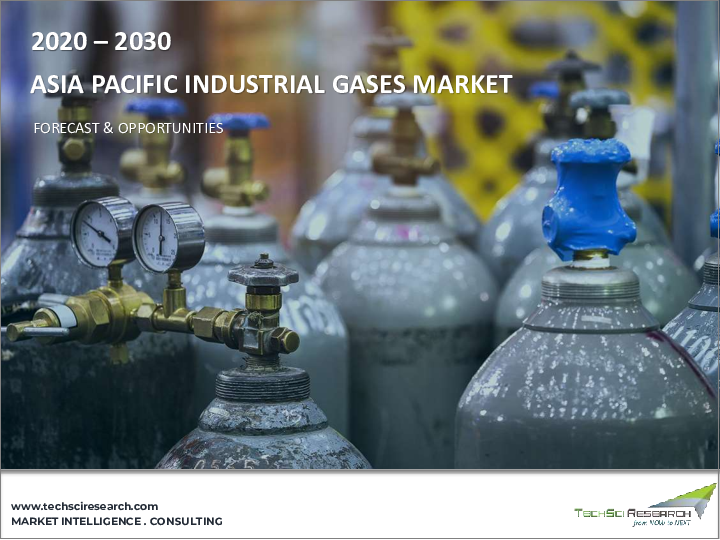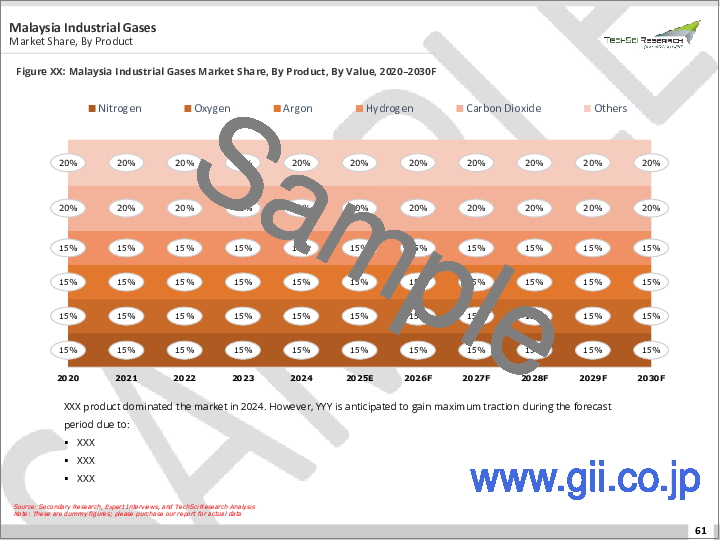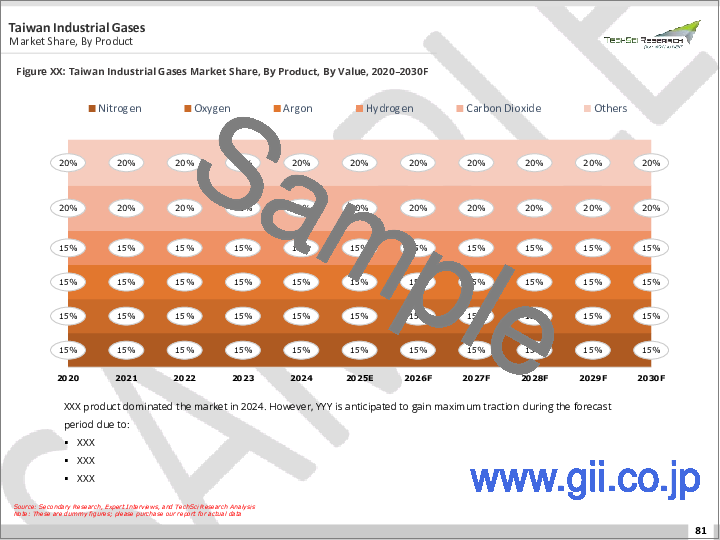|
|
市場調査レポート
商品コード
1331410
アジア太平洋の産業ガス市場- 世界の産業規模、シェア、動向、機会、予測、2018-2028年Asia Pacific Industrial Gases Market - Global Industry Size, Share, Trends, Opportunity, and Forecast, 2018-2028 Segmented By Type, By End-User Industry, By Distribution, By Region, and Competition |
||||||
カスタマイズ可能
|
|||||||
| アジア太平洋の産業ガス市場- 世界の産業規模、シェア、動向、機会、予測、2018-2028年 |
|
出版日: 2023年08月01日
発行: TechSci Research
ページ情報: 英文 88 Pages
納期: 2~3営業日
|
- 全表示
- 概要
- 目次
アジア太平洋の産業ガス市場は、燃料電池、輸送、工業プロセスなど幅広い用途で水素の需要が増加していることから、2024年から2028年の予測期間中に著しい成長が見込まれています。
世界の建設セクターの約58.3%は中国、インド、米国、インドネシアが占めており、中国だけで世界成長の26.1%を占めています。
再生可能エネルギーへの関心の高まりが産業ガス需要を牽引
アジア太平洋地域における再生可能エネルギーへの注目は、産業ガス市場、特に水素製造に大きな影響を与えると予想されます。水素は将来の重要なエネルギーキャリアと考えられており、低炭素エネルギーシステムへの移行において重要な役割を果たす可能性を秘めています。風力発電や太陽光発電などの再生可能エネルギーを利用して、電気分解により水素を製造することに、各メーカーの関心が高まっています。このプロセスでは、電流を使って水を水素と酸素に分解し、水素を燃料として使用したり、後で使用するために貯蔵したりします。アジア開発銀行(ADB)は、ベトナムのニントゥアン省にある88メガワット(MW)の風力発電所の運営を支援するため、BIM Wind Power Joint Stock Company(BIMウィンド社)とのプロジェクトに1億700万米ドルの融資を行うことに調印しました。したがって、このプロジェクトでは、風をエネルギーに変換し、産業ガスのエス需要を促進するために、大量の産業ガスが必要となります。
アジア太平洋地域で再生可能エネルギーの需要が伸び続ける中、これらの技術開発を支える産業ガス、特に水素の需要が増加する可能性が高いです。さらに、水素の製造、貯蔵、輸送には、冷却や加圧に使用される窒素やヘリウムを含むさまざまな産業ガスが必要です。日本や韓国などの国々は、水素を重要なエネルギー源として開発することに特に力を入れており、両国とも水素インフラと技術の開発に多額の投資を行っています。
さらに、中国やオーストラリアなど、この地域の他の国々も水素の生産と利用への注力を強めており、産業ガス市場で事業を展開する企業にチャンスを提供しています。従って、アジア太平洋地域における再生可能エネルギー源への注目は、産業ガス市場の水素セグメントの成長を促進し、再生可能エネルギー部門のニーズを満たすために事業を拡大し、新製品とサービスを開発する企業に機会を提供し、アジア太平洋の産業ガス市場の成長を増加させると予想されます。
建設・製造部門からの需要増が産業ガス市場の成長促進要因
インフラ整備はアジア太平洋の産業ガス市場、特に建設・製造セクターの成長の主な要因です。酸素、窒素、アルゴンなどの産業ガスは、溶接、切断、金属加工などさまざまな用途に使用されるため、需要はこれらの分野の成長と密接に結びついています。アジア太平洋地域は、特に中国、インド、東南アジアなどの国々でインフラ整備が著しく進んでいます。新しい高速道路、鉄道、空港、その他のインフラ・プロジェクトの開発には、溶接、切断、金属加工などの活動のためのさまざまな産業ガスが必要です。
さらに、アジア太平洋地域における製造業の成長は、産業ガス需要の主要な原動力となっています。鉄鋼生産、化学加工、電子機器製造などの製造活動は大量の産業ガスを必要とし、中でも窒素と酸素が最も多く使用されています。中国の一帯一路構想や東南アジアの日印パートナーシップのようなインフラ・プロジェクトの発展は、この地域の産業ガス需要を促進すると予想されます。さらに、中国や韓国などの国々におけるエレクトロニクス産業の成長も、産業ガス市場の成長に寄与すると予想されます。したがって、同地域における建設・製造活動の増加は、産業ガス需要を増加させ、アジア太平洋の産業ガス市場の成長を促進すると予想されます。
最近の動き
アジア太平洋の産業ガス市場では近年、市場シェアの拡大や市場競争力の向上を目指す企業によるM&A、パートナーシップ、提携が大きな動向となっています。M&Aによる市場の統合は、企業の効率向上とコスト削減につながり、新技術や新市場へのアクセス拡大につながっています。
- 2018年には、リンデAGとプラクセア社の買収により、世界最大の産業ガス会社が誕生しました。この合併により、時価総額900億米ドルを超える業界最大手の2社が統合されました。合併後のリンデplcは100カ国以上で事業を展開し、ヘルスケア、製造、エネルギーなど幅広い産業にサービスを提供しています。
- 2018年、大陽日酸はPraxairの欧州ガス事業を59億米ドルで買収し、これにより大陽日酸は欧州での事業を拡大し、大規模な顧客基盤を持ち、昨年の年間売上高は約20億米ドルに達しました。
- 2020年、エア・リキードと豊田通商株式会社は、燃料電池車の開発を支援し、二酸化炭素排出量を削減することを目的とした、日本における水素インフラ整備のためのパートナーシップを発表しました。
- エア・リキードはインドネシアで新しい空気分離装置(ASU)に投資します。2021年操業開始予定のASUは、エレクトロニクス、鉄鋼、化学など様々な産業向けに酸素、窒素、アルゴンを生産します。
利用可能なカスタマイズ
TechSciリサーチは、所定の市場データを用いて、企業固有のニーズに応じたカスタマイズを提供します。レポートでは以下のカスタマイズが可能です:
企業情報
- 追加市場参入企業(最大5社)の詳細分析とプロファイリング
目次
第1章 概要
第2章 調査手法
第3章 エグゼクティブサマリー
第4章 顧客の声
第5章 アジア太平洋の産業ガス市場展望
- 市場規模と予測
- 金額ベース
- 市場シェアと予測
- タイプ別(窒素、酸素、アルゴン、水素、二酸化炭素、その他)
- エンドユーザー別(冶金、溶接、医療、化学・石油化学、飲食品、その他)
- 流通別(オンサイト、バルク、シリンダー、その他)
- 地域別
- 企業別(2022年)
- 市場マップ
- タイプ別
- エンドユーザー別
- 流通別
- 地域別
- アジア太平洋地域国別分析
- 中国
- インド
- 日本
- 韓国
- オーストラリア
- マレーシア
- シンガポール
- ベトナム
- インドネシア
- 台湾
第6章 市場力学
- 促進要因
- 課題
第7章 市場動向と発展
- 製品上市
- 合併・買収
- 技術の進歩
第8章 アジア太平洋の産業ガス市場SWOT分析
第9章 ポーターのファイブフォース分析
- 業界内の競合
- 新規参入の可能性
- サプライヤーの力
- 顧客の力
- 代替品の脅威
第10章 競合情勢
- Business Overview
- Product Offerings
- Recent Developments
- Financials(In Case of Listed Companies)
- Key Personnel
- Taiyo Nippon Sanso Corporation
- Southern Industrial Gas Sdn. Bhd.
- Iwatani Corporation
- BASF SE
- The Linde Group
- Goyal MG Gases Pvt. Ltd.
- Air Liquide
- Asia Technical Gas Co(Pte)Ltd(ATG)
- Sig Gases Bhd
- Air Products and Chemicals Shanghai Co. Ltd.
第11章 戦略的提言
第12章 調査会社について・免責事項
Asia Pacific Industrial Gases Market is anticipated to grow appreciably in the forecast period of 2024- 2028 due to the increasing demand for hydrogen in a wide range of applications, including fuel cells, transportation, and industrial processes. Approximately 58.3% of global construction sector is accounted for by China, India, the US, and Indonesia, where China alone holds 26.1% of global growth.
The Asia Pacific Industrial Gases Market is a rapidly growing market that includes the production and distribution of gases such as oxygen, nitrogen, hydrogen, carbon dioxide, and others. The region is home to some of the world's largest industrial gas companies and has seen significant growth in recent years due to several key drivers, such as demand for healthcare services and favorable government policies.
Asia Pacific Industrial Gases Market is the region where the manufacturing sector is expanding at a high pace. Many countries in the region, such as China, India, Japan, and South Korea, have seen significant growth in their manufacturing industries over the past decade, driven by increasing demand for goods and services both domestically and internationally. Industrial gases are essential in the manufacturing process of many products, including electronics, chemicals, and metals, making the growth of the manufacturing sector a key driver of the industrial gas market in the region.
The Asia Pacific Industrial Gases Market is being driven by the region's increasing focus on renewable energy sources. With countries in the region increasingly looking to reduce their carbon footprint, there is a growing demand for industrial gases such as hydrogen, which can be used as a clean energy source. Hydrogen can be used to power fuel cells, which are being increasingly used in the automotive industry as a clean alternative to traditional gasoline-powered engines. As companies in the industry continue to invest in research and development and expand their operations in the region, the market is likely to remain highly competitive and dynamic. Therefore, Asia Pacific Industrial Gases Market is expected to continue to grow in the upcoming years.
Growing Focus on the Renewable Energy Sources in the Region is Driving the Industrial Gases Demand
The focus on renewable energy sources in the Asia Pacific region is expected to have a significant impact on the industrial gas market, particularly in hydrogen production. Hydrogen is seen as a key energy carrier for the future and has the potential to play an important role in the transition to a low-carbon energy system. It is observed that manufacturers have increased their interest in using renewable energy sources, such as wind and solar power, to produce hydrogen through electrolysis. This process involves splitting water into hydrogen and oxygen using an electrical current, with the hydrogen then used as a fuel source or stored for later use. The Asian Development Bank (ADB) signed to provide USD 107 million in financing to the project with BIM Wind Power Joint Stock Company (BIM Wind) to back the operation of an 88-megawatt (MW) wind farm in Ninh Thuan province, Viet Nam. Hence, the project will need a significant amount of industrial gases to convert wind into energy and propel eth demand for industrial gases.
As the demand for renewable energy sources continues to grow in the Asia Pacific region, there is likely to be an increasing demand for industrial gases, particularly hydrogen, to support the development of these technologies. In addition, the production, storage, and transportation of hydrogen require a range of industrial gases, including nitrogen and helium, which are used for cooling and pressurization. Countries such as Japan and South Korea are particularly focused on developing hydrogen as a key energy source, with both countries investing heavily in the development of hydrogen infrastructure and technologies.
In addition, other countries in the region, such as China and Australia, are increasing their focus on hydrogen production and utilization, providing opportunities for companies operating in the industrial gas market. Therefore, the focus on renewable energy sources in the Asia Pacific region is expected to drive the growth of the hydrogen segment of the industrial gases market, providing opportunities for companies to expand their operations and develop new products and services to meet the needs of the renewable energy sector and increase the Asia Pacific Industrial Gases Market growth.
Rising Demand From Construction and Manufacturing Sectors are Factors driving the Industrial Gases Market Growth.
Infrastructure development is a key driver of growth in the Asia Pacific Industrial Gases Market, particularly in the construction and manufacturing sectors. The demand for industrial gases such as oxygen, nitrogen, and argon is closely tied to the growth of these sectors, as these gases are used for a range of applications, including welding, cutting, and metal fabrication. The Asia Pacific region has seen a significant increase in infrastructure development, particularly in countries such as China, India, and Southeast Asia. The development of new highways, railways, airports, and other infrastructure projects require a range of industrial gases for activities such as welding, cutting, and metal fabrication.
Moreover, the growth of the manufacturing sector in the Asia Pacific region has been a key driver of demand for industrial gases. Manufacturing activities such as steel production, chemical processing, and electronics manufacturing require large quantities of industrial gases, with nitrogen and oxygen being among the most used industrial gases. The development of infrastructure projects such as the Belt and Road Initiative in China and the India-Japan partnership in Southeast Asia are expected to drive demand for industrial gases in the region. In addition, the growth of the electronics industry in countries such as China and South Korea is also expected to contribute to the growth of the industrial gas market. Hence, the rising construction and manufacturing activities in the region are expected to increase the demand for industrial gases and drive the Asia Pacific industrial gases market growth.
Recent Developments
Mergers & acquisitions, partnerships, and collaborations have been a significant trend in the Asia Pacific Industrial Gases Market in recent years as companies seek to expand their market share and improve their competitiveness in the region. The consolidation of the market through mergers and acquisitions has led to increased efficiency and reduced costs for companies, and increased access to new technologies and markets.
- In 2018, the acquisition of Linde AG and Praxair, Inc. created the world's largest industrial gas company. The merger brought together two of the largest companies in the industry, with a combined market value of over $90 billion. The merged company, Linde plc, operates in more than 100 countries and serves a wide range of industries, including healthcare, manufacturing, and energy.
- In 2018, Taiyo Nippon Sanso Corporation acquired Praxair's European gas business for USD 5.9 billion, which helped Taiyo Nippon Sanso Corporation to expand the company's operations in Europe, have the large customer base and annual sales of approx. USD 2 billion last year.
- In 2020, Air Liquide and Toyota Tsusho Corporation announced a partnership to develop hydrogen infrastructure in Japan, which aims to support the development of fuel cell vehicles and reduce carbon emissions.
- Air Liquide's investment in a new air separation unit (ASU) in Indonesia. The ASU, which is expected to start operations in 2021, will produce oxygen, nitrogen, and argon for various industries, including electronics, steel, and chemicals.
Market Segmentation
Asia Pacific Industrial Gases Market is segmented based on type, end-user, distribution, and region. Based on type, the market is fragmented into nitrogen, oxygen, argon, hydrogen, carbon dioxide, and others. Based on end-user, the market is categorized into metallurgy, welding, medical, chemical & petrochemical, food & beverage, and others. Based on Distribution, the market is divided into on-site, bulk, cylinder, and other. Based on region, the market is divided into North America, Europe, Asia Pacific, South America, Middle East & Africa.
Company Profiles
Taiyo Nippon Sanso Corporation, Southern Industrial Gas Sdn. Bhd., Iwatani Corporation, BASF SE, The Linde Group, Goyal MG Gases Pvt. Ltd., Air Liquide, Asia Technical Gas Co (Pte) Ltd (ATG), Sig Gases Bhd, and Air Products and Chemicals Shanghai Co. Ltd. are some of the key players of Asia Pacific industrial gases Market.
Report Scope:
In this report, Asia Pacific Industrial Gases market has been segmented into the following categories, in addition to the industry trends, which have also been detailed below:
Asia Pacific Industrial Gases Market, By Type:
- Nitrogen
- Oxygen
- Argon
- Hydrogen
- Carbon Dioxide
- Others
Asia Pacific Industrial Gases Market, By End User:
- Metallurgy
- Welding
- Medical
- Chemical & Petrochemical
- Food & Beverage
- Others
Asia Pacific Industrial Gases Market, By Distribution:
- On-site
- Bulk
- Cylinder
- Other
Asia Pacific Industrial Gases Market, By Region:
- China
- India
- Japan
- South Korea
- Australia
- Malaysia
- Singapore
- Vietnam
- Indonesia
- Taiwan
Competitive landscape
Company Profiles: Detailed analysis of the major companies present in the Asia Pacific Industrial Gases market.
Available Customizations:
With the given market data, TechSci Research offers customizations according to a company's specific needs. The following customization options are available for the report:
Company Information
- Detailed analysis and profiling of additional market players (up to five).
Table of Contents
1. Product Overview
- 1.1. Market Definition
- 1.2. Scope of the Market
- 1.2.1. Markets Covered
- 1.2.2. Years Considered for Study
- 1.2.3. Key Market Segmentations
2. Research Methodology
- 2.1. Objective of the Study
- 2.2. Baseline Methodology
- 2.3. Key Industry Partners
- 2.4. Major Association and Secondary Sources
- 2.5. Forecasting Methodology
- 2.6. Data Triangulation & Validation
- 2.7. Assumptions and Limitations
3. Executive Summary
- 3.1. Overview of the Market
- 3.2. Overview of Key Market Segmentations
- 3.3. Overview of Key Market Players
- 3.4. Overview of Key Regions/Countries
- 3.5. Overview of Market Drivers, Challenges, Trends
4. Voice of Customer
5. Asia Pacific Industrial Gases Market Outlook
- 5.1. Market Size & Forecast
- 5.1.1. By Value
- 5.2. Market Share & Forecast
- 5.2.1. By Type (Nitrogen, Oxygen, Argon, Hydrogen, Carbon Dioxide, and Others)
- 5.2.2. By End User (Metallurgy, Welding, Medical, Chemical & Petrochemical, Food & Beverage, and Others)
- 5.2.3. By Distribution (On-site, Bulk, Cylinder, and Other)
- 5.2.4. By Region
- 5.2.5. By Company (2022)
- 5.3. Market Map
- 5.3.1. By Type
- 5.3.2. By End User
- 5.3.3. By Distribution
- 5.3.4. By Region
- 5.4. Asia Pacific: Country Analysis
- 5.4.1. China Industrial Gases Market Outlook
- 5.4.1.1. Market Size & Forecast
- 5.4.1.1.1. By Value
- 5.4.1.2. Market Share & Forecast
- 5.4.1.2.1. By Type
- 5.4.1.2.2. By End User
- 5.4.1.2.3. By Distribution
- 5.4.1.1. Market Size & Forecast
- 5.4.2. India Industrial Gases Market Outlook
- 5.4.2.1. Market Size & Forecast
- 5.4.2.1.1. By Value
- 5.4.2.2. Market Share & Forecast
- 5.4.2.2.1. By Type
- 5.4.2.2.2. By End User
- 5.4.2.2.3. By Distribution
- 5.4.2.1. Market Size & Forecast
- 5.4.3. Japan Industrial Gases Market Outlook
- 5.4.3.1. Market Size & Forecast
- 5.4.3.1.1. By Value
- 5.4.3.2. Market Share & Forecast
- 5.4.3.2.1. By Type
- 5.4.3.2.2. By End User
- 5.4.3.2.3. By Distribution
- 5.4.3.1. Market Size & Forecast
- 5.4.4. South Korea Industrial Gases Market Outlook
- 5.4.4.1. Market Size & Forecast
- 5.4.4.1.1. By Value
- 5.4.4.2. Market Share & Forecast
- 5.4.4.2.1. By Type
- 5.4.4.2.2. By End User
- 5.4.4.2.3. By Distribution
- 5.4.4.1. Market Size & Forecast
- 5.4.5. Australia Industrial Gases Market Outlook
- 5.4.5.1. Market Size & Forecast
- 5.4.5.1.1. By Value
- 5.4.5.2. Market Share & Forecast
- 5.4.5.2.1. By Type
- 5.4.5.2.2. By End User
- 5.4.5.2.3. By Distribution
- 5.4.5.1. Market Size & Forecast
- 5.4.6. Malaysia Industrial Gases Market Outlook
- 5.4.6.1. Market Size & Forecast
- 5.4.6.1.1. By Value
- 5.4.6.2. Market Share & Forecast
- 5.4.6.2.1. By Type
- 5.4.6.2.2. By End User
- 5.4.6.2.3. By Distribution
- 5.4.6.1. Market Size & Forecast
- 5.4.7. Singapore Industrial Gases Market Outlook
- 5.4.7.1. Market Size & Forecast
- 5.4.7.1.1. By Value
- 5.4.7.2. Market Share & Forecast
- 5.4.7.2.1. By Type
- 5.4.7.2.2. By End User
- 5.4.7.2.3. By Distribution
- 5.4.7.1. Market Size & Forecast
- 5.4.8. Vietnam Industrial Gases Market Outlook
- 5.4.8.1. Market Size & Forecast
- 5.4.8.1.1. By Value
- 5.4.8.2. Market Share & Forecast
- 5.4.8.2.1. By Type
- 5.4.8.2.2. By End User
- 5.4.8.2.3. By Distribution
- 5.4.8.1. Market Size & Forecast
- 5.4.9. Indonesia Industrial Gases Market Outlook
- 5.4.9.1. Market Size & Forecast
- 5.4.9.1.1. By Value
- 5.4.9.2. Market Share & Forecast
- 5.4.9.2.1. By Type
- 5.4.9.2.2. By End User
- 5.4.9.2.3. By Distribution
- 5.4.9.1. Market Size & Forecast
- 5.4.10. Taiwan Industrial Gases Market Outlook
- 5.4.10.1. Market Size & Forecast
- 5.4.10.1.1. By Value
- 5.4.10.2. Market Share & Forecast
- 5.4.10.2.1. By Type
- 5.4.10.2.2. By End User
- 5.4.10.2.3. By Distribution
- 5.4.10.1. Market Size & Forecast
- 5.4.1. China Industrial Gases Market Outlook
6. Market Dynamics
- 6.1. Drivers
- 6.2. Challenges
7. Market Trends & Developments
- 7.1. Product Launches
- 7.2. Mergers & Acquisitions
- 7.3. Technological Advancements
8. Asia Pacific Industrial Gases Market: SWOT Analysis
9. Porter's Five Forces Analysis
- 9.1. Competition in the Industry
- 9.2. Potential of New Entrants
- 9.3. Power of Suppliers
- 9.4. Power of Customers
- 9.5. Threat of Substitute Application s
10. Competitive Landscape
- 10.1. Business Overview
- 10.2. Product Offerings
- 10.3. Recent Developments
- 10.4. Financials (In Case of Listed Companies)
- 10.5. Key Personnel
- 10.5.1. Taiyo Nippon Sanso Corporation
- 10.5.2. Southern Industrial Gas Sdn. Bhd.
- 10.5.3. Iwatani Corporation
- 10.5.4. BASF SE
- 10.5.5. The Linde Group
- 10.5.6. Goyal MG Gases Pvt. Ltd.
- 10.5.7. Air Liquide
- 10.5.8. Asia Technical Gas Co (Pte) Ltd (ATG)
- 10.5.9. Sig Gases Bhd
- 10.5.10. Air Products and Chemicals Shanghai Co. Ltd.





